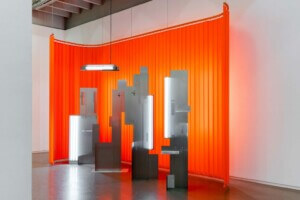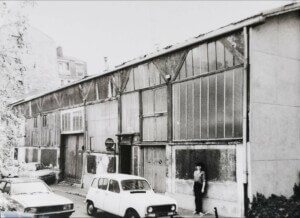For one delirious week, visitors to the Jewish Museum in New York could view the exhibit Pierre Chareau: Modern Architecture and Design downstairs, and go upstairs to see the exhibition The Arcades: Contemporary Art and Walter Benjamin. Chareau—the architect of the famous Parisian Maison de Verre—escaped successfully from Nazi Paris to New York, while Benjamin did not. In all probability, Benjamin never visited Chareau’s super-deluxe, bourgeois home-office of Dr. Jean Dalsace (built 1928–32), despite Benjamin’s admiration for metal-and-glass building fabrication as a symbol of modern life—following the modernist architectural historian Siegfried Gideon.
Benjamin, like the Surrealist poet Louis Aragon, author of Paris Peasant (1927), preferred to enjoy the ruins of bourgeois life: the decaying 19th-century glass-covered Parisian shopping arcades. There, the Surrealists met in their favorite cafe and imagined assignations with prostitutes, posing as tailors, service personnel, photographers, card engravers, or launderers in the small shops of the arcade. Before his suicide at the Spanish border fleeing the Nazis in 1940, Benjamin wrote the short essay “Paris: Capital of the 19th Century” (1935). This outlined his intention, beginning with the arcades, to describe the history of Paris as a modern city through its detritus—its fragmentary waste and destruction. It was a part of his larger project for a negative history of the bourgeoisie.
In contrast to the clarity and precision of the Diller Scofidio + Renfro–designed Chareau exhibition downstairs, with its historical documentation, imaginative recreations, virtual reality, and moving sectional projections, the Benjamin Arcades exhibition is perhaps appropriately a jumble of fragments. This impression seems strange at first, as Benjamin’s most famous essay, “The Work of Art in the Age of Mechanical Reproduction” (1936), was a model of clarity, founding the discipline of modern media studies in mass societies. Here, Benjamin identified the handcraft aura of true artistic production as a still-humanist value in a modern, Marxist universe. Chareau’s handcrafted machine design downstairs might seem to successfully exemplify this desire for authenticity, yet nothing of this exemplary quality appears upstairs.
Benjamin’s unfinished Arcades Project consisted of 26 alphabetically ordered folders in capital letters—ten in lower case—with seemingly random titles containing photographs, research material, press cuttings, and pieces of his text that might be useful for the project. These are like word clouds surrounding a confusing and complex hidden virtual object of intellectual inquiry that would emerge in writing. Many scholars have investigated, prodded, and projected their thoughts into these word clouds, searching their meaning for several generations. The catalogue contains two worthy essays further contributing to this enormous scholarship, one explicitly exploring Benjamin’s idea of an urban, collective “optical unconscious.” Each exhibition piece is itself accompanied by a word cloud created by the contemporary American poet Kenneth Goldsmith. (There are also conventional wall texts.)
The idea of linking each of Benjamin’s alphabetical Parisian folders to a contemporary art piece drove the selection of the exhibition, which is entered through a ghostly and deliberately weak re-creation of a scaled-down Parisian arcade. Cindy Sherman, disguised as “a collector” in a huge framed photograph, confronts this tight entry in by far the most powerful correlation in the show. Sherman’s art of disguising her personal identity in other people’s apparatuses, clothes, styling, and cosmetics, ties directly to Benjamin’s reading of the modern city.
This selection highlights masks, alienation, and the “sandwich-board men” of Benjamin’s youth who carried advertisements on their fronts and backs on the Berlin sidewalks, hiding their humanity, like the Surrealists’ vision of the prostitutes marketing their beauty and bodies as products in the arcades. Other choices like an early Andy Warhol movie (in the “Boredom” folder!) echo this weakly. Still other choices, like Chris Burden’s miniature Tower of London Bridge model from a child’s construction kit, mock Benjamin’s enthusiastic predilection for the Positivist triumphs of bourgeois civil engineering (following Gideon), such as giant iron bridges and the Eiffel Tower.
The problem of the exhibition arises from the supposition that it is possible now to make a correct correlation back to Benjamin’s fragmentary notes that carries any real meaning. We live in a very different age of digital, not mechanical, reproduction. It is an age in which Sherman represents the new normal of what Benjamin would have called, following Marx, commodity fetishes and distractive phantasmagoria. As an architect and urbanist, I found Lee Friedlander’s 2011 photographs of New York shop windows reflecting the street, buildings, and sidewalks, and showing the clothing mannequins, to be the most evocative of Benjamin’s much-cited flâneur (whose leisurely gaze captured the working life of the city and its denizens). My other favorite item was only in the catalogue, a Benjamin’s Dream comic book (2016) by Vito Manola Roma. Here all of Benjamin’s fears and insecurities about capitalist monsters, women and sex, the city and infinite mazes, alienation and authenticity come alive in an evocative, furious, sometimes violent literary and visual fantasy world.
Benjamin’s unfinished project and fragmentary notes do remind us of just how fragile bourgeois life, freedoms, and culture are in times of economic distress and political extremism. Benjamin was a complicated character: a Marxist who resisted Communism having visited Moscow, a high bourgeois who sought social justice and a decent life for the majority following Bertolt Brecht, a secular, rational modernist who thought there were limits to our knowledge and believed in ancient myths, like the Jewish Kabbalah.
Leaving the aesthetics of the Arcades exhibition aside and its distractive phantasmagoria behind, and returning to the world outside, we enter the universe that drove him to suicide. The curators of this exhibition could not have foreseen this contemporary turn of American politics. So sadly, this exhibition reminds us powerfully of our own fragile situation and Benjamin’s horrible, confused, depressed, and weakened condition at the Spanish frontier in 1940. His companions crossed the frontier the next day; let us hope we will be so lucky.
The Arcades: Contemporary Art and Walter Benjamin
The Jewish Museum
Through August 6










